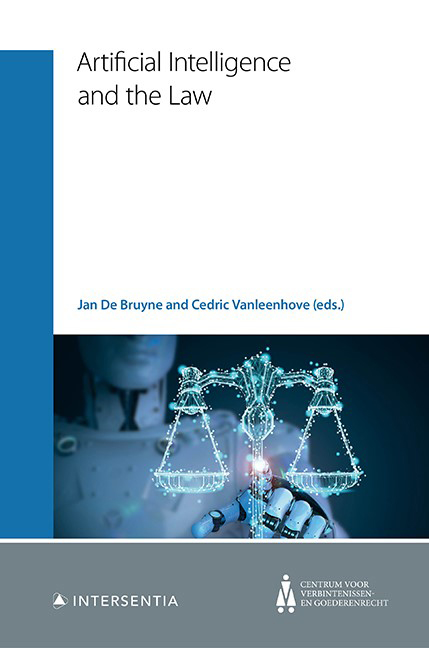Book contents
- Frontmatter
- Contents
- Foreword
- Contributing Authors
- Chapter 1 Basic Concepts of AI for Legal Scholars
- Chapter 2 Different Models of Innovation and Their Relation to Law
- Chapter 3 Setting the Scene: On AI Ethics and Regulation
- Chapter 4 Quantitative Legal Prediction: the Future of Dispute Resolution?
- Chapter 5 AI Arbitrators … ‘Does Not Compute’
- Chapter 6 AI through a Human Rights Lens. The Role of Human Rights in Fulfilling AI’s Potential
- Chapter 7 Killer Robots: Lethal Autonomous Weapons and International Law
- Chapter 8 AI and Data Protection: the Case of Smart Home Assistants
- Chapter 9 AI and IP: a Tale of Two Acronyms
- Chapter 10 Tax and Robots
- Chapter 11 Robotisation and Labour Law. The Dark Factory: the Dark Side of Work?
- Chapter 12 The Hypothesis of Technological Unemployment Caused by AI-Driven Automation and its Impact on Social Security Law
- Chapter 13 AI in Belgian Contract Law: Disruptive Challenge or Business as Usual?
- Chapter 14 Tort Law and Damage Caused by AI Systems
- Chapter 15 Insurance Underwriting on the Basis of Telematics: Segmentation and Profiling
- Chapter 16 AI and Creditworthiness Assessments: the Tale of Credit Scoring and Consumer Protection. A Story with a Happy Ending?
- Chapter 17 AI and the Consumer
- Chapter 18 Robots and AI in the Healthcare Sector: Potential Existing Legal Safeguards Against a(n) (Un)justified Fear for ‘Dehumanisation’ of the Physician-Patient Relationship
Chapter 2 - Different Models of Innovation and Their Relation to Law
Published online by Cambridge University Press: 26 May 2021
- Frontmatter
- Contents
- Foreword
- Contributing Authors
- Chapter 1 Basic Concepts of AI for Legal Scholars
- Chapter 2 Different Models of Innovation and Their Relation to Law
- Chapter 3 Setting the Scene: On AI Ethics and Regulation
- Chapter 4 Quantitative Legal Prediction: the Future of Dispute Resolution?
- Chapter 5 AI Arbitrators … ‘Does Not Compute’
- Chapter 6 AI through a Human Rights Lens. The Role of Human Rights in Fulfilling AI’s Potential
- Chapter 7 Killer Robots: Lethal Autonomous Weapons and International Law
- Chapter 8 AI and Data Protection: the Case of Smart Home Assistants
- Chapter 9 AI and IP: a Tale of Two Acronyms
- Chapter 10 Tax and Robots
- Chapter 11 Robotisation and Labour Law. The Dark Factory: the Dark Side of Work?
- Chapter 12 The Hypothesis of Technological Unemployment Caused by AI-Driven Automation and its Impact on Social Security Law
- Chapter 13 AI in Belgian Contract Law: Disruptive Challenge or Business as Usual?
- Chapter 14 Tort Law and Damage Caused by AI Systems
- Chapter 15 Insurance Underwriting on the Basis of Telematics: Segmentation and Profiling
- Chapter 16 AI and Creditworthiness Assessments: the Tale of Credit Scoring and Consumer Protection. A Story with a Happy Ending?
- Chapter 17 AI and the Consumer
- Chapter 18 Robots and AI in the Healthcare Sector: Potential Existing Legal Safeguards Against a(n) (Un)justified Fear for ‘Dehumanisation’ of the Physician-Patient Relationship
Summary
INTRODUCTION
1. An innovation is the application of a new or significantly improved product (good or service) or process; a new marketing method; or a new organisational method in business practices, workplace organisation, or external relations. It involves the realisation that products, services, means of production, marketing strategies, delivery methods, and business structures do not take a fixed form but rather are subject to change, either incremental or radical. This chapter concerns innovation policy and what governments ought to do to secure the process by which companies inject novelty into the market. Therefore, it deals with different legal rules for commercial innovations. It does not deal with the underproduction of basic research within an economy or, for instance, the task of the state to produce basic research. Our economies have been engaging with innovation at a rapid pace, and research now revolves around the question of how the tax code can streamline and promote this evolution. Governments have adopted this goal: to ‘promote innovation, encourage the development of new technologies and increase the fund of human knowledge’. Tax law is seen as one of the main toolkits by lawyers, economists, and policy-makers. National economies are competing internationally for the price of the most innovative economy, and our tax codes have been subject to fierce innovation too. In a political environment where governments are pushed to ‘create growth’, favourable R&D treatment has now turned into the panacea of innovation policy. Favourable R&D treatment, such as the allocations of R&D to foreign income, the R&D tax credit, the R&D favourable deduction scheme, and patent boxes, are seldom-contested tax expenditures that are the biggest tax expenditures for many big economies.
2. Western legal systems follow the OECD and the World Bank and welcome tax incentives for research and development (R&D) as a sound innovation policy. In the European Union, nearly all Member States adopted tax subsidies for R&D expenditures. Belgium recently enforced and reformed its incentives for innovation, hereby following the Base Erosion and Profit Shifting initiative from the OESO.
- Type
- Chapter
- Information
- Artificial Intelligence and the Law , pp. 23 - 48Publisher: IntersentiaPrint publication year: 2021



